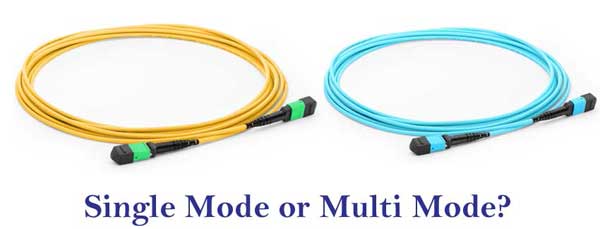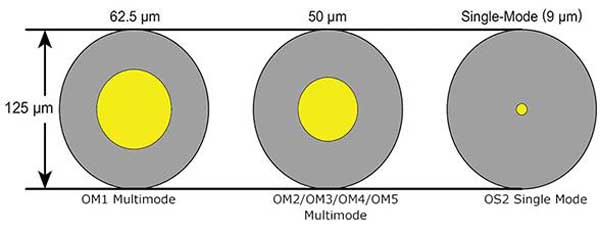Although single mode fiber and multimode fiber are widely used in various applications, the difference between them is still
confusing. When installing fiber optic cabling, one of the most important
questions is whether to install single mode fiber or multimode fiber. This
article will compare single-mode and multimode fibers around basic structure,
bandwidth, fiber distance, fiber color, and cost.

What’s the Difference Between Single Mode and Multimode Fiber Optic Cable?
Single Mode Fiber Cable: Single mode fiber is a
common fiber used for long distance transmission. Single mode fiber is a single
glass fiber bundle used to transmit single mode or light. Single mode fiber has
only one transmission mode. Single mode fiber is also called single mode fiber,
single mode fiber, single mode fiber and single mode optical waveguide.
Multimode Fiber Cable: Multimode fiber is a kind
of fiber designed to transmit multiple rays or modes at the same time, and the
reflection angle of each ray or mode in the fiber core is slightly different.
Construction
The core diameter of single mode fiber is much
smaller than that of multimode fiber. Single mode fiber is designed to
propagate a single optical mode, while multimode supports multiple simultaneous
optical modes. Single mode and multimode cables are constructed differently.
The fiber core of a single mode fiber optic cable is 9 μm, and the fiber core
of modern multimode fiber optic cables is 50 μm, but the fiber core of older
fiber optic cables (especially OM1 optical cables) is 62.5 μm.

Bandwidth
The bandwidth of single mode fiber is significantly
higher than that of multimode fiber. Single mode cables support light sources
with higher brightness, higher power, and lower attenuation. And multimode
relies on the transmission of multiple light modes with lower brightness and
higher attenuation.
Distance
Single mode fiber supports short distance
transmission and long distance transmission, regardless of signal bandwidth
and/or resolution. The transmission distance of single mode fiber can reach 40
kilometers or more without damaging the signal, so it is very suitable for long
distance applications. The maximum transmission distance of multimode affected
by the cable grade is much shorter, making it an ideal choice for indoor
applications.
Color
Single mode optical fibers are covered with yellow
outer sheaths, and multimode optical fibers are covered with orange or light
green sheaths.
Cost
For short distance applications, multimode fiber is still a more cost-effective choice than single mode fiber. Multimode
transceivers are usually two to three times cheaper than single mode
transceivers. As faster optoelectronic technologies mature and output
increases, the prices of both are falling, and the cost gap between multimode
and single mode has narrowed. Finally, the fact that multimode fibers are
easier to install and terminate in the field and it is an important
consideration for corporate environments because they are frequently moved,
added, and changed.
Conclusion
In general, single mode optical fiber cabling
systems are suitable for long distance data transmission applications, while multimode optical fiber cabling systems have shorter distances. You can choose
the most suitable network needs based on your total fiber cost.
Baudcom offers all
kinds of fiber optic cables. For more information, please visit Baudcom.
What is the main difference between SMF and MMF fiber optical cable?